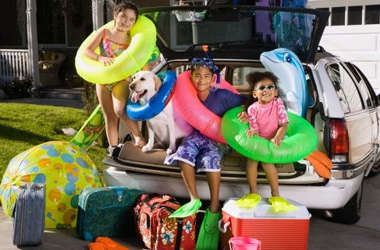'Situational Awareness' Key to Avoiding Problems during Travel Season
Q&A with UAlbany Center for Public Health Preparedness Director Edward Waltz
 |
|
When traveling -- even to a known place -- there are new challenges and unfamiliar environments. Maintaining 'situational awareness' can help avoid potential pitfalls, according to UAlbany's CPHP.
|
ALBANY, N.Y. (May 25, 2012) -- With gas prices declining and organizations such as Airlines for America (A4A) predicting an increase in international fliers, the summer travel season in the United States is shaping up to be one of the busiest on record.
University at Albany Center for Public Health Preparedness Director Edward Waltz is an expert in emergency preparedness, disease surveillance systems and local public health services. A research associate professor of Health Policy Management and Behavior at UAlbanys School of Public Health, Waltz offers tips for vacationers on how to avoid health and safety risks associated with summer and holiday travel.
Q: What is ‘situational awareness,’ and why is it an important term for vacationers to remember?
A: When training professionals in preparedness programs, we use terms like vulnerability assessment, threat environment, and situational awareness. While these have specific meanings in the context of community preparedness, they also translate into daily living, especially when traveling.
When you are at home or work, you are in a familiar environment, where you know the risks and you can control many of them. When traveling -- even to a known place -- there are new challenges and unfamiliar environments.
The most important rule is to maintain 'situational awareness' in all circumstances. That involves being aware of the environment and potential threats around you at all times. If you can anticipate higher-risk situations you’re likely to encounter, you'll have a better idea of what to look for to reduce risks and plan appropriate responses.
 |
|
CPHP Director Ed Waltz
|
Q: How does ‘preparedness’ apply to summer or holiday travel?
A: Like everything in preparedness, planning starts well before the event. Conduct a simple vulnerability analysis —what are the adverse events or conditions you can anticipate at each stage? This would include the possibility of mechanical failure, effects of adverse weather, and other causes of breakdown or accident. The Internet offers detailed lists of recommended emergency supplies.
If bad weather is forecasted, check local weather reports regularly. If you have a smart phone or cell modem, New York State’s web site http://www.511ny.org provides detailed, up-to-the- minute information on road closures, accidents, and traffic conditions. Before your trip, bookmark that web site and any 511 sites for all states on your itinerary.
Q: What other specific threats apply to vacationers who are driving?
A: When you stop at a highway rest area, you should recognize that it represents a different kind of threat environment including the risk of both infectious diseases and personal safety issues:
- Hundreds of people touch virtually every surface even after being cleaned. Avoid touching anything unnecessarily with your bare hands. Always use a hand sanitizer before returning to your vehicle to reduce the risk of spreading contamination.
- During travel season, rest areas overflow with children just released from hours of confinement in a traveling vehicle. All of that pent-up energy is released the minute they come inside. The near pandemonium is a perfect environment for someone to snatch a wallet left temporarily on the counter, grab a purse, or even kidnap a child— and get away unnoticed in the confusion. When you enter the building, take note of any uniformed security personnel, so that you can find them quickly in the event of a crime or missing child.
Q: What are the health and safety issues when traveling by air at this time?
A: While certain strains of illness such as influenza are more prevalent during winter months, travelers may be at risk for other diseases depending on the nature of their travel plans. If traveling internationally, especially to unfamiliar areas, educate yourself on any threats to personal safety in, or near your destination. The U.S. State Department has an excellent website with specific safety alerts and a wide range of other travel advice to facilitate international travel.
Whether you’re traveling out of the country or flying domestic, delays and cancellations could extend your trip by an extra day or two. If you do not have a cell phone, consider buying a pre-paid phone just for the trip. It will greatly simplify making alternative arrangements in case of such emergencies. Carry extra doses of prescription medications and original prescriptions on longer trips. Contingency planning is key.
Q: What is the role of the Center for Public Health Preparedness?
A: The University at Albany’s Center for Public Health Preparedness (CPHP) trains public health practitioners and provides technical assistance to community partners in emergency preparedness. Funded through Centers for Disease Control, the Center conducts both direct and distance-based trainings, assists community partners with drills and exercises, and supports academic education in preparedness.
CPHP’s scope involves all-hazards preparedness: While preparedness centers initially focused primarily on bioterrorism, we now know that there are more similarities than differences in the way communities respond to hazards ranging from bomb attacks and flu pandemics to hurricanes. This is codified in the federal “Pandemic And All Hazards Preparedness Act” (PAHPA) which is now up for renewal in Congress.
![]() For more news, subscribe to UAlbany's RSS headline feeds
For more news, subscribe to UAlbany's RSS headline feeds
Educationally and culturally, the University at Albany-SUNY puts "The World Within Reach" for its 17,500 students. An internationally recognized research university with 50 undergraduate majors and 125 graduate degree programs, UAlbany is a leader among all New York State colleges and universities in such diverse fields as public policy, nanotechnology and criminal justice. With a curriculum enhanced by 300 study-abroad opportunities, UAlbany launches great careers. For more information about this globally ranked University, visit https://www.albany.edu/. For UAlbany's extensive roster of faculty experts, visit www.albany.edu/news/experts.shtml.




